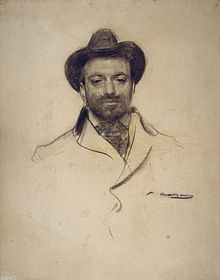Josep Maria Sert
Josep Maria Sert | |
|---|---|
 Portrait of Sert by Ramon Casas (MNAC) | |
| Born | Josep Maria Sert i Badia 21 December 1874 Barcelona, Spain |
| Died | 27 November 1945 (aged 70) Barcelona, Spain |
| Resting place | Vic Cathedral |
| Known for | Murals |
| Style | Grisaille |
| Movement | Baroque |
| Spouses | |
Josep Maria Sert i Badia (Catalan pronunciation:
Career
Sert initially studied art in Rome before moving to
Sert was commissioned in 1900 to paint the interior of the Vic Cathedral in the Province of Barcelona, Catalonia in murals, which took him more than 30 years to complete.[2][3]
By 1910, Sert had begun fully focusing on murals and other large-scale work. He collaborated with Russian Sergei Diaghilev to create sets for his Ballets Russes.[1] In 1929 he was commissioned with the elaboration of a series of large forma canvases painted in his signature grisaille style intending to cover the walls of the reconverted San Telmo church in Donostia-San Sebastián; they portray different historic chapters of the Basques in an epic manner.[4]
In the United States, Sert painted a mural at the
Personal life
Sert began an affair with the well-known pianist and patron of the arts Misia Godebska in 1908.[6] They married on 2 September 1920.[7] In 1925, Sert met Georgian-Russian sculptor Isabelle Roussadana Mdivani, known as Roussy, who subsequently moved in with him and Misia.[6] Sert began an affair with Roussy and later divorced Misia on 28 December 1927 to marry Mdivani.[7][6][8][9]
Roussy and Sert were married in 1928 in a civil ceremony at the consulate in The Hague.[6] In 1930, they were married in a religious ceremony at the Spanish church in Paris.[6]
After Roussy died in 1938, Sert reconciled with Misia and returned to life with her, though they kept separate apartments.[7][6]
Sert died on 27 November 1945 in Barcelona, and left his apartment and furnishings to Misia.[7][6]
Gallery
-
Apollo flying through the Clouds (1913)
-
Satyr watching some Nymphs dancing (1913)
-
The Elephant Fountain (1913)
-
The Fountains Bridge (1913)
-
The Triumph of Apollo (1913)
References
- ^ a b c d e f g "Who is Jose Maria Sert?". At Rockefeller Center. 12 May 2015. Retrieved 8 June 2017.
- ^ "José María Sert (1874-1945)". Museo Nacional Centro de Arte Reina Sofía. Retrieved 8 June 2017.
- ^ "Josep Maria Sert". Encyclopædia Britannica. 2016. Retrieved 8 June 2017.
- OCLC 1010512377.
- ^ "American Progress". Rockefeller Center. Tishman Speyer. Retrieved 8 June 2017.
- ^ a b c d e f g "Misia, Queen of Paris". Musée d'Orsay. 2006. Retrieved 7 June 2017.
- ^ a b c d "Sert, Misia (1872–1950)". Women in World History: A Biographical Encyclopedia. Encyclopedia.com. 7 June 2017. Retrieved 7 June 2017.
- ISBN 978-0-307-59263-7.
- ISBN 9781442253339.
External links
- See the murals at the Rockefeller Center in New York City.

